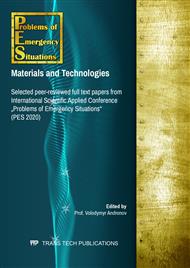[1]
A.I. Kovalov, Y.A. Otrosh, T.M. Kovalevska and S.O. Safronov, Methodology for assessment of the fire-resistant quality of reinforced-concrete floors protected by fire-retardant coatings, IOP Conf. Series: Materials Science and Engineering. 708 (2019) 012058.
DOI: 10.1088/1757-899x/708/1/012058
Google Scholar
[2]
A. Kovalov, V. Konoval, A. Khmyrova, K. Dudko, Parameters for simulation of the thermal state and fire-resistant quality of hollow-core floors used in the mining industry, E3S Web of Conferences. 123 (2019) 01022.
DOI: 10.1051/e3sconf/201912301022
Google Scholar
[3]
I.V. Abramov, M.V. Gravit, E.I. Gumerova, Povyshenie predelov ognestoykosti sudovykh i stroitelnykh konstruktsiy pri uglevodorodnom temperaturnom rezhime, Gazovaya promyshlennost. 5 (2018) 108–117.
Google Scholar
[4]
J.K. Paik, J. Czujko, Assessment of hydrocarbon explosion and fire risks in offshore installations: Recent advances and future trends, IES Journal Part A: Civil and Structural Engineering. 4 (2016) 167–179.
DOI: 10.1080/19373260.2011.593345
Google Scholar
[5]
M. Imran, M.S. Liew, M.S. Nasif, U.M. Niazi, A. Yasreen, Hazard assessment studies on hydrocarbon fire and blast: An overview, Advanced Science Letters. 23 (2017) 1243–1247.
DOI: 10.1166/asl.2017.8349
Google Scholar
[6]
S.A. Shvyrkov, Ya.I. Yurev, D.N. Pristupyuk, Rezultaty eksperimentalnykh issledovaniy prochnostnykh kharakteristik razlichnykh tipov betona v usloviyakh uglevodorodnogo pozhara, Tekhnologii tekhnosfernoy bezopasnosti. 1 (2017) 93–98.
Google Scholar
[7]
P. Krivenko, S. Guzii, L. Bodnarova, J. Valek, R. Hela and J. Zach, Effect of thickness of the intumescent alkali aluminosilicate coating on temperature distribution in reinforced concrete, Journal of Building Engineering. 8 (2016) 14-19.
DOI: 10.1016/j.jobe.2016.09.003
Google Scholar
[8]
Y. Otrosh, M. Surianinov, A. Golodnov, O. Starova, Experimental and Computer Researches of Ferroconcrete Beams at High-Temperature Influences, In Materials Science Forum. 968 (2019) 355-360.
DOI: 10.4028/www.scientific.net/msf.968.355
Google Scholar
[9]
A. Vasilchenko, E. Doronin, B. Ivanov, V. Konoval, Effect of Residual Deformation of a Steel Column on its Fire Resistance under Combined Exposure Explosion-Fire,, In Materials Science Forum. 968 (2019) 288-293.
DOI: 10.4028/www.scientific.net/msf.968.288
Google Scholar
[10]
A. Kovalov, Y. Otrosh, O. Ostroverkh, O. Hrushovinchuk, O. Savchenko, Fire resistance evaluation of reinforced concrete floors with fire-retardant coating by calculation and experimental method, E3S Web of Conferences. 60 (2018) 00003.
DOI: 10.1051/e3sconf/20186000003
Google Scholar
[11]
EN 1992–1–2: 2004 Eurocode 2: Design of concrete structures. Part 1–2: General rules. Structural fire design Brussels: The European Union Per Regulation.
DOI: 10.1002/9783433601570.oth1
Google Scholar


